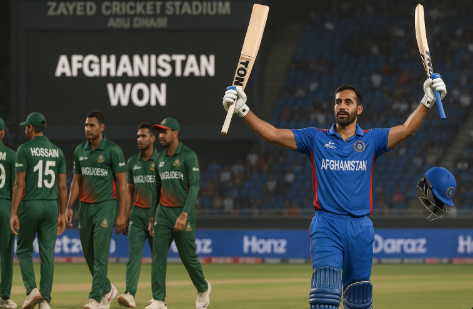Bangladesh vs Afghanistan: A Wake-Up Call for Tigers

Bangladesh vs Afghanistan: A Match of Contrasts
The first ODI between Bangladesh vs Afghanistan on October 8, 2025, at the Zayed Cricket Stadium in Abu Dhabi was more than just a match. It was a test of Bangladesh’s consistency, adaptability, and mental resilience after their T20 clean sweep over the same opponent.
While the Tigers entered the series with confidence, Afghanistan flipped the script with a commanding five-wicket win. This defeat not only broke Bangladesh’s momentum but also highlighted the gaps that continue to haunt their ODI performance.
According to ESPN Cricinfo, Bangladesh posted 221 all out in 48.5 overs, a total far below modern ODI standards. Afghanistan responded with 226 for 5, chasing down the target in 47.1 overs. The hero of the day was Azmatullah Omarzai, who took three wickets and later scored a match-winning 40 off 44 balls.
This result serves as an early warning for Bangladesh as the ODI World Cup cycle nears, demanding introspection and tactical recalibration.
Bangladesh’s Batting Collapse: A Recurring Concern
The Bangladesh batting lineup once again struggled to adapt to conditions that required patience and shot selection. After choosing to bat first, the team failed to capitalize on the powerplay overs. Early wickets put them under pressure, forcing the middle order to consolidate rather than accelerate.
In the last 12 months, Bangladesh’s average first-innings score in ODIs has hovered around 245, significantly below top-tier teams like India (289) or England (305). This stat underlines their inability to post match-winning totals, especially outside home conditions.
The top order, which includes experienced players like Litton Das and Najmul Hossain Shanto, has been inconsistent. Their average partnership in 2025 ODIs stands at just 28 runs, a worrying trend for a side that depends heavily on solid starts.
You can explore Bangladesh’s recent ODI performance trends on Cricbuzz.
Afghanistan’s Rise: Discipline and Consistency
Afghanistan’s victory was not accidental. It was built on discipline, planning, and confidence. Their bowlers executed specific plans for every batter, cutting down scoring options with tight lines.
Azmatullah Omarzai led the attack with 3 wickets for 40 runs, while veteran spinner Rashid Khan applied pressure in the middle overs. Afghanistan’s fielding also stood out, with sharp catches and agile movement that saved 15–20 runs — a crucial difference in a low-scoring match.
This disciplined approach reflects Afghanistan’s growing maturity in international cricket. They are no longer underdogs. With consistent performances in both the T20 World Cup 2024 and recent bilateral series, Afghanistan has established itself as one of the most dangerous emerging teams in the world.
Learn more about Afghanistan’s cricket development journey from ICC Official Reports.
Bangladesh’s Bowling: Decent but Not Dominant
On paper, Bangladesh’s bowling attack remains strong, featuring Mustafizur Rahman, Taskin Ahmed, and Mehidy Hasan Miraz. However, against Afghanistan, the bowlers failed to apply consistent pressure.
Mustafizur provided an early breakthrough, but the lack of follow-up wickets allowed Afghanistan to rebuild through partnerships. Taskin’s economy rate exceeded 5.8 runs per over, and spinners failed to extract enough turn despite favorable conditions.
Bangladesh’s bowling has averaged 5.7 wickets per ODI in 2025, compared to Afghanistan’s 7.3 wickets, revealing a key difference in impact. The Tigers need better control in middle overs to prevent easy singles and keep the run rate climbing.
Fielding and Fitness: The Hidden Weakness
Another recurring issue for Bangladesh is fielding. Dropped catches and sluggish ground fielding once again cost valuable runs. While Afghanistan saved nearly 20 runs through athletic fielding, Bangladesh conceded extras through overthrows and misfields.
According to BCB’s internal fitness reports, fielding efficiency dropped by 8% compared to 2023, particularly among senior players. This directly affects match outcomes, especially in tight games like this one.
To compete at the global level, Bangladesh must match the energy levels of teams like Australia and India, where fitness and fielding are now as important as batting averages.
Azmatullah Omarzai: The Game-Changer
If one player defined the match, it was Azmatullah Omarzai. His all-round brilliance changed the course of the game. His three wickets dismantled Bangladesh’s middle order, and his calm batting under pressure ensured a smooth chase.
In 2025, Omarzai has emerged as one of Afghanistan’s top ODI performers, averaging 38 with the bat and 26 with the ball. His rise mirrors Afghanistan’s overall progress in developing match-winning all-rounders, a department where Bangladesh is still searching for balance.
The Player of the Match award was well deserved, reflecting his growing reputation as one of Asia’s most impactful cricketers.
Bangladesh’s Middle-Order Woes Continue
A major concern for Bangladesh in ODIs has been the lack of a reliable middle order. After Shakib Al Hasan, there is a noticeable gap in experience and temperament. Youngsters like Towhid Hridoy and Afif Hossain show promise but often fail to convert starts into substantial scores.
Bangladesh’s middle order averages just 27.3 runs per batter in 2025 ODIs, compared to Afghanistan’s 34.2. This gap often makes the difference between posting 220 and reaching a competitive 280.
To fix this, Bangladesh needs more clarity in roles. Batters must rotate strike better and avoid collapses between overs 25–40, a period where the team often loses control.
What Bangladesh Can Learn from This Defeat
Losing a match is not the problem. Failing to learn from it is. Bangladesh must use this defeat as a blueprint for improvement before the second ODI.
They need to:
- Strengthen partnerships in both top and middle order.
- Improve fielding drills and match fitness.
- Encourage strike rotation instead of boundary dependency.
- Create wicket-taking pressure through smart bowling changes.
Coach Chandika Hathurusingha and captain Najmul Hossain Shanto now have the challenge of bringing calm and focus before the next match.
For deeper statistical insights, check ICC Men’s ODI Rankings.
A Look Ahead: Can Bangladesh Bounce Back?
Bangladesh trails 0–1 in the three-match ODI series. The upcoming matches in Abu Dhabi and Sharjah will decide whether they can level the series or fall short again.
The key lies in tactical flexibility. Bangladesh must adapt to slow, dry pitches that benefit spinners and require smart batting. The inclusion of experienced players like Mushfiqur Rahim or Mahmudullah in the next match could stabilize the lineup.
Fans still believe in the team’s ability to bounce back. After all, Bangladesh has a history of learning quickly from defeats. Their comeback against Zimbabwe and Sri Lanka earlier this year shows that the Tigers can roar again when their backs are against the wall.
The Wake-Up Call for the Tigers
The first ODI of the Bangladesh vs Afghanistan series was a sobering reminder that past success means little without consistency. Bangladesh remains a talented and passionate side, but to compete with top-tier nations, they must evolve tactically and mentally.
This match may not define their journey, but it should redefine their approach. The Tigers have the skill to dominate. What they now need is discipline, adaptability, and unity.
As the series continues, fans hope this defeat becomes the turning point that reignites Bangladesh’s fighting spirit.







